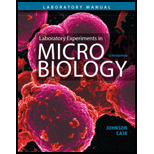
Was the test performed in this exercise a direct or an indirect ELISA test?
To fill:
Indirect ELISA.
Introduction:
Immunoassays are tests done for the diagnosis of diseases by identifying the presence of antigen or a particular antibody from a patient's sample. Antigen-Antibody interactions form the basis of immunoassays wherein interactions like agglutinations, precipitation is seen. Immunoassays using enzyme labels are termed as ELISA-Enzyme Linked ImmunoSorbent Assay.
Answer to Problem 1Q
The test performed in this exercise is indirect ELISA.
Explanation of Solution
In Indirect ELISA first the antigen is added to the well and then the primary antibody is added. After the buffer wash, enzyme-labeled secondary antibody is added which binds to the Antigen-primary antibody complex. Finally, the substrate corresponding to the enzyme is added, which forms a color emitting enzyme-substrate complex. The color change indicates that appropriate Antibody is present in the patient's sample.
In this exercise, initially, S.entericaTyphimurium (antigen) is added, and the patient's serum (i.e primary antibody) is added followed by the addition of alkaline phosphatase labeled with secondary antibody. Finally, the alkaline phosphatase substrate (BCIP/NBT) is added in order to give color if there is an interaction between the antigen and the primary antibody.
Hence the test followed in the exercise is Indirect ELISA.
Want to see more full solutions like this?
Chapter 44 Solutions
Laboratory Experiments in Microbiology (12th Edition) (What's New in Microbiology)
- What did the Cre-lox system used in the Kikuchi et al. 2010 heart regeneration experiment allow researchers to investigate? What was the purpose of the cmlc2 promoter? What is CreER and why was it used in this experiment? If constitutively active Cre was driven by the cmlc2 promoter, rather than an inducible CreER system, what color would you expect new cardiomyocytes in the regenerated area to be no matter what? Why?arrow_forwardWhat kind of organ size regulation is occurring when you graft multiple organs into a mouse and the graft weight stays the same?arrow_forwardWhat is the concept "calories consumed must equal calories burned" in regrads to nutrition?arrow_forward
- You intend to insert patched dominant negative DNA into the left half of the neural tube of a chick. 1) Which side of the neural tube would you put the positive electrode to ensure that the DNA ends up on the left side? 2) What would be the internal (within the embryo) control for this experiment? 3) How can you be sure that the electroporation method itself is not impacting the embryo? 4) What would you do to ensure that the electroporation is working? How can you tell?arrow_forwardDescribe a method to document the diffusion path and gradient of Sonic Hedgehog through the chicken embryo. If modifying the protein, what is one thing you have to consider in regards to maintaining the protein’s function?arrow_forwardThe following table is from Kumar et. al. Highly Selective Dopamine D3 Receptor (DR) Antagonists and Partial Agonists Based on Eticlopride and the D3R Crystal Structure: New Leads for Opioid Dependence Treatment. J. Med Chem 2016.arrow_forward
- The following figure is from Caterina et al. The capsaicin receptor: a heat activated ion channel in the pain pathway. Nature, 1997. Black boxes indicate capsaicin, white circles indicate resinferatoxin. You are a chef in a fancy new science-themed restaurant. You have a recipe that calls for 1 teaspoon of resinferatoxin, but you feel uncomfortable serving foods with "toxins" in them. How much capsaicin could you substitute instead?arrow_forwardWhat protein is necessary for packaging acetylcholine into synaptic vesicles?arrow_forward1. Match each vocabulary term to its best descriptor A. affinity B. efficacy C. inert D. mimic E. how drugs move through body F. how drugs bind Kd Bmax Agonist Antagonist Pharmacokinetics Pharmacodynamicsarrow_forward
 Principles Of Radiographic Imaging: An Art And A ...Health & NutritionISBN:9781337711067Author:Richard R. Carlton, Arlene M. Adler, Vesna BalacPublisher:Cengage Learning
Principles Of Radiographic Imaging: An Art And A ...Health & NutritionISBN:9781337711067Author:Richard R. Carlton, Arlene M. Adler, Vesna BalacPublisher:Cengage Learning





